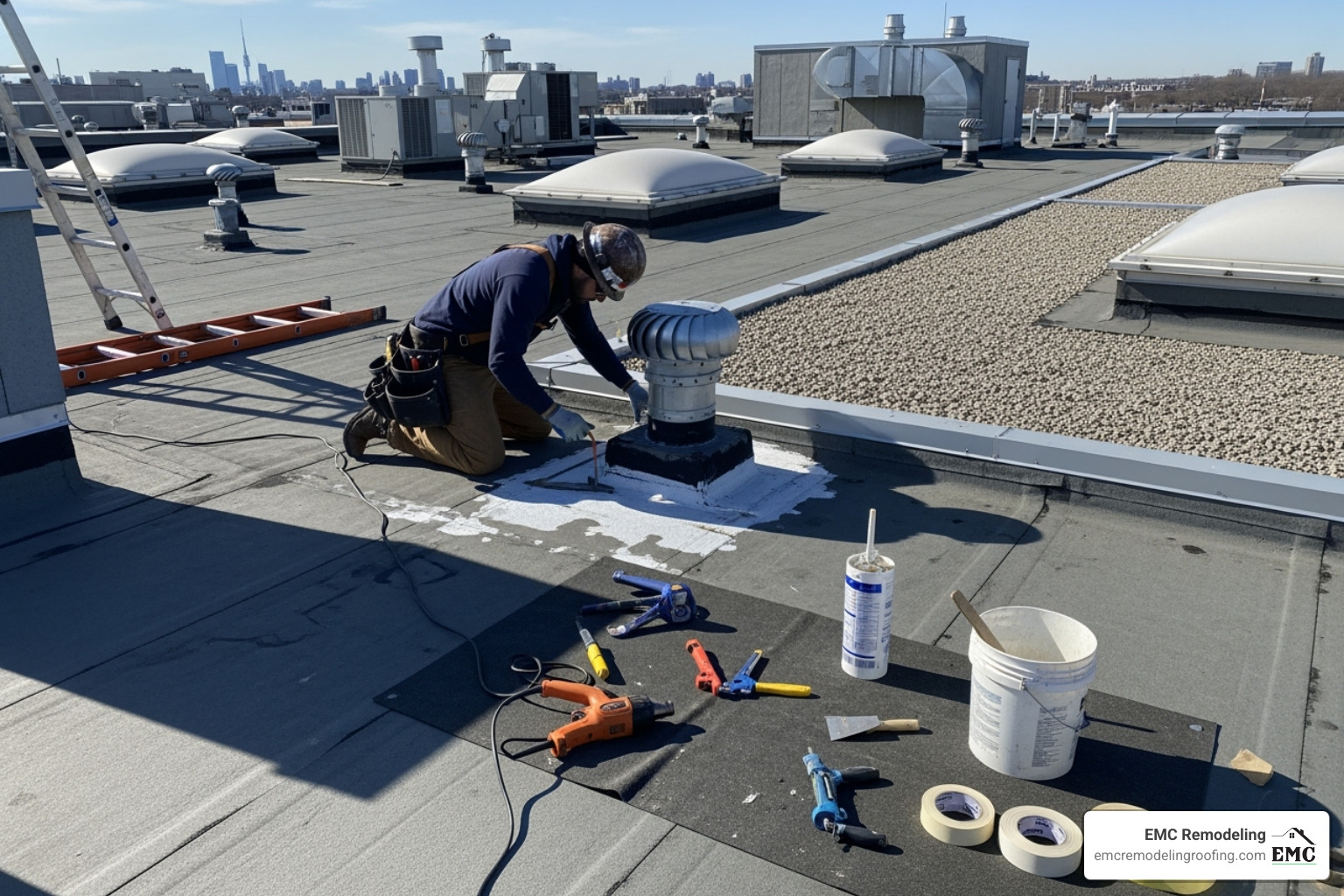Save Thousands on Water Damage: A Central Texas Guide to Flat Roof Repair
Flat roof repair is a critical maintenance task that can save Central Texas homeowners thousands of dollars in water damage and energy costs. Understanding when and how to address flat roof issues ensures your home stays protected from the extreme weather conditions we face in our region.
Quick Flat Roof Repair Guide:
- Common Issues: Pooling water, membrane cracks, damaged flashing, and punctures
- Warning Signs: Water stains on ceilings, visible membrane damage, unusually high energy bills
- Repair Process: Clean area → Remove damaged material → Apply roofing cement → Add fiberglass mesh → Seal patch
- When to Call Pros: Extensive damage, structural issues, TPO/PVC repairs, or safety concerns
- Expected Lifespan: 15-25 years with proper maintenance and quality materials
Flat roofs have become increasingly popular in Central Texas due to their cost-effectiveness and modern aesthetic. However, they face unique challenges from our extreme temperature fluctuations and intense summer heat. Unlike pitched roofs that naturally shed water, flat roofs require more attention to prevent issues like pooling water and membrane deterioration.
The key to successful flat roof ownership lies in understanding your roofing system and taking proactive steps. This comprehensive guide will walk you through everything you need to know about flat roof maintenance and repair to protect your investment.
I’m Matt Runyon, President of EMC Remodeling & Roofing, with over 15 years of experience helping Central Texas homeowners with flat roof repair and maintenance solutions. Our family-owned company has seen how proper care can extend a flat roof’s lifespan and prevent costly emergency repairs.
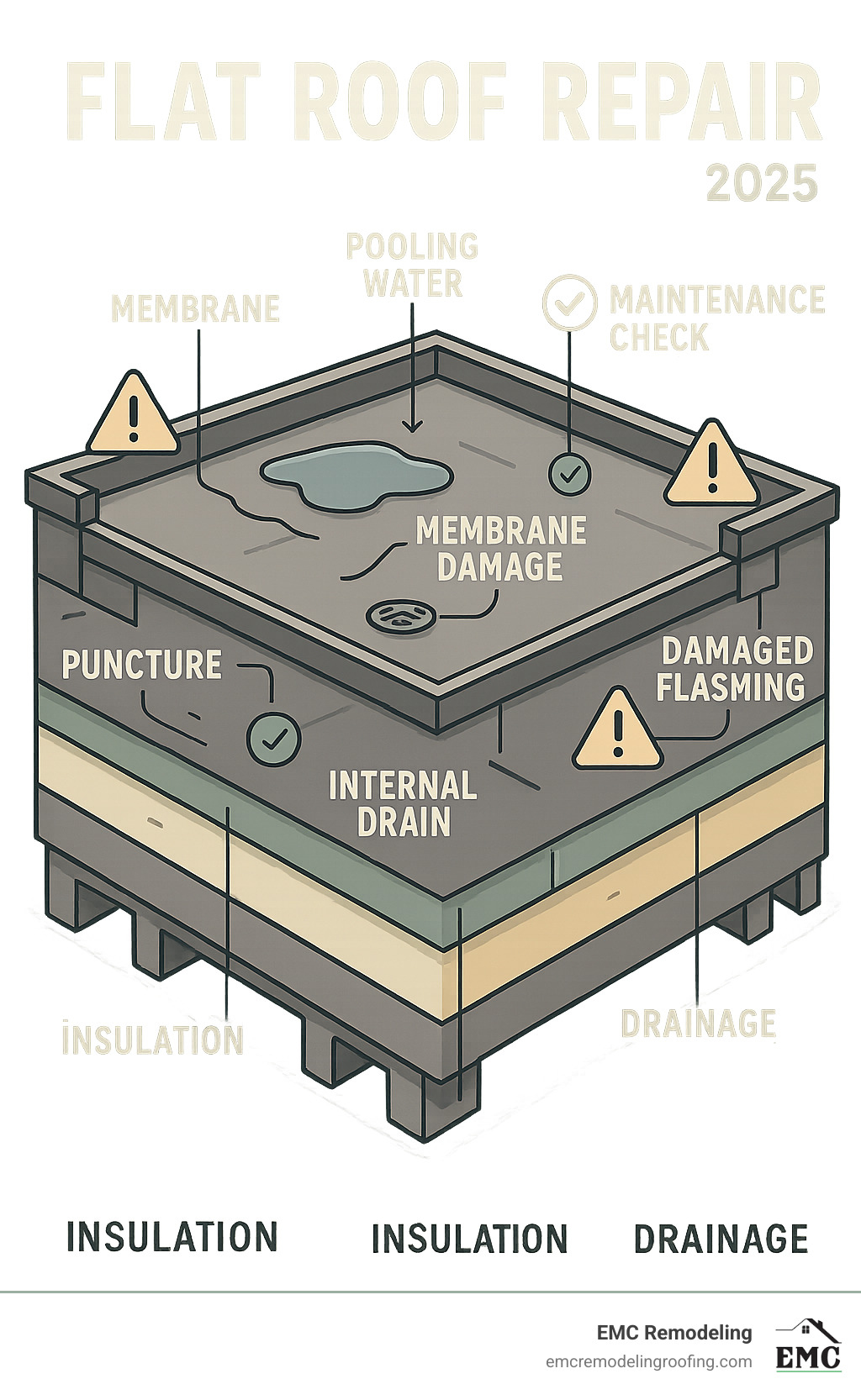
EPDM vs. TPO vs. Mod-Bit: Which Flat Roof Material Lasts 25+ Years in Texas?
Choosing the right material for your flat roof is like picking the perfect outfit for a Texas summer – it needs to be durable, efficient, and able to withstand the heat! The material you choose, along with the quality of installation and ongoing maintenance, directly impacts your roof’s longevity. While a flat roof generally lasts upwards of 15-25 years, this lifespan depends heavily on workmanship, the quality of materials, and the severity of local weather.
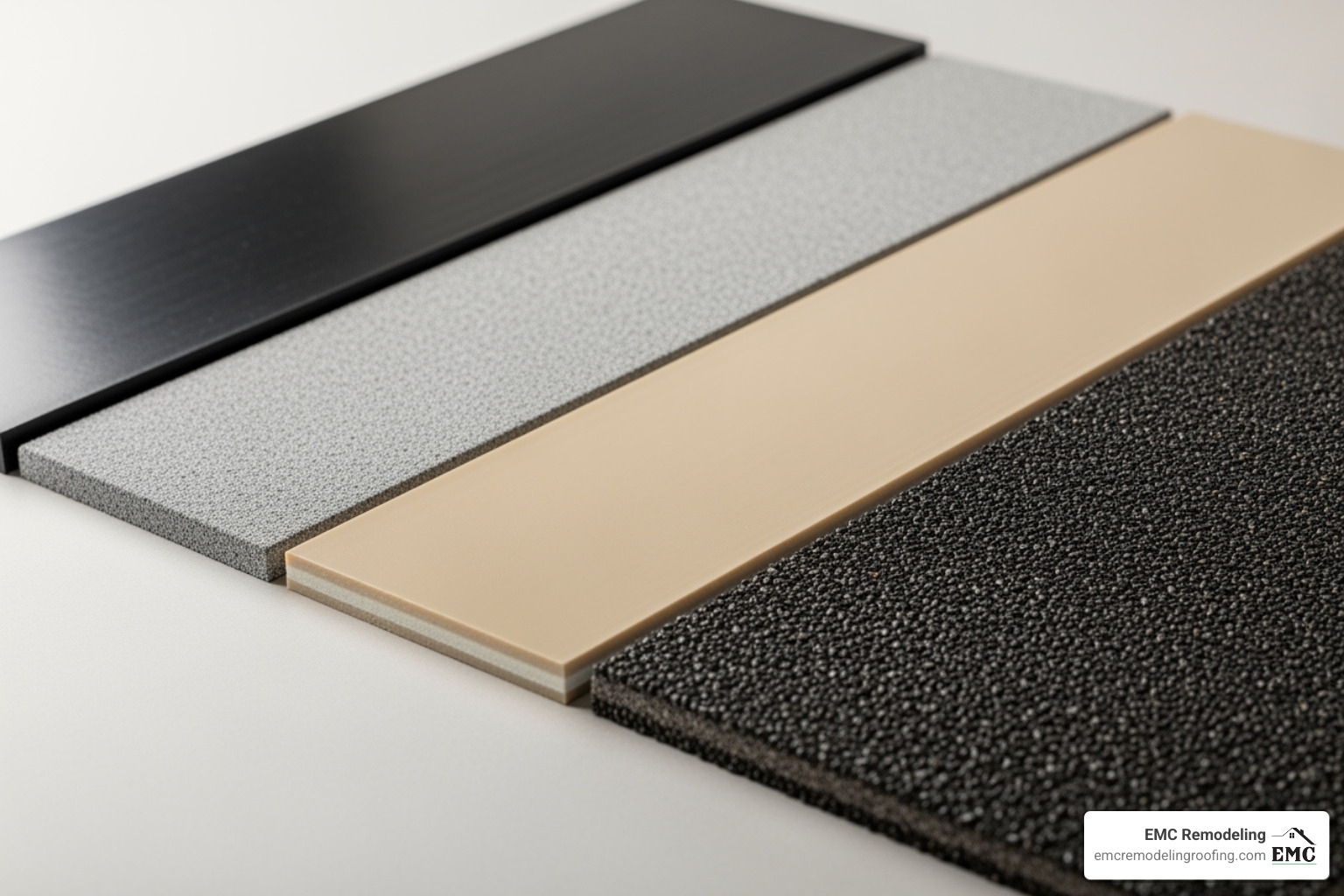
Here’s a look at the common types of flat roofing materials we work with and their unique characteristics:
| Material Type | Pros | Cons | Typical Lifespan |
|---|---|---|---|
| EPDM (Rubber) | Flexible, durable, easy to repair, cost-effective | Vulnerable to punctures, can absorb heat (dark color) | 20-25 years |
| TPO & PVC | Energy-efficient (reflective), strong seams, lightweight | Requires specialized installation, can be pricier | 15-25 years |
| Modified Bitumen | Multi-layer protection, durable, fire-resistant | Torch-down application risks (fire), heavier | 10-20 years |
EPDM (Rubber) Roofing
Ethylene Propylene Diene Monomer, or EPDM, is a synthetic rubber roofing membrane that’s been a popular choice for decades. Think of it as a giant, durable rubber sheet. Its flexibility allows it to withstand temperature fluctuations without cracking, which is a huge plus in our Texas climate. EPDM is relatively easy to repair, making it a cost-effective option for long-term maintenance. However, it can be vulnerable to punctures from falling debris or foot traffic, and its dark color can absorb heat unless treated with a reflective coating. With proper care, an EPDM roof can easily last 20-25 years.
TPO & PVC Roofing
Thermoplastic Olefin (TPO) and Polyvinyl Chloride (PVC) are single-ply roofing membranes known for their energy efficiency. Often bright white, these materials reflect sunlight, significantly reducing heat absorption and helping to keep your building cooler, which translates to lower energy bills – a true blessing in Texas! Their seams are heat-welded, creating an incredibly strong, watertight bond that’s often stronger than the material itself. This makes them highly resistant to leaks. However, TPO and PVC require specialized tools and expertise for installation and repair, meaning they’re not typically a DIY project.
Modified Bitumen & BUR
Modified Bitumen (Mod-Bit) and Built-Up Roofing (BUR) are asphalt-based systems that offer multi-layer protection. Mod-Bit is a modern evolution of BUR, incorporating polymers for added flexibility and durability. BUR, often called “tar and gravel” roofs, uses alternating layers of asphalt and reinforced fabrics, topped with gravel for UV protection. These systems are known for their robustness and fire resistance. While durable, Modified Bitumen often involves a “torch-down” application, which carries inherent fire risks if not performed by highly trained professionals. BUR systems can also be quite heavy, requiring a strong roof deck to support them.
7 Warning Signs of Flat Roof Failure (And How to Catch Them Early)
Your flat roof works hard to protect your home, but it’s easy to forget about it until something goes wrong. The trouble is, by the time you notice a problem inside your house, the damage outside has often been building for weeks or even months. Learning to spot the early warning signs can save you from costly repairs and water damage headaches down the road.
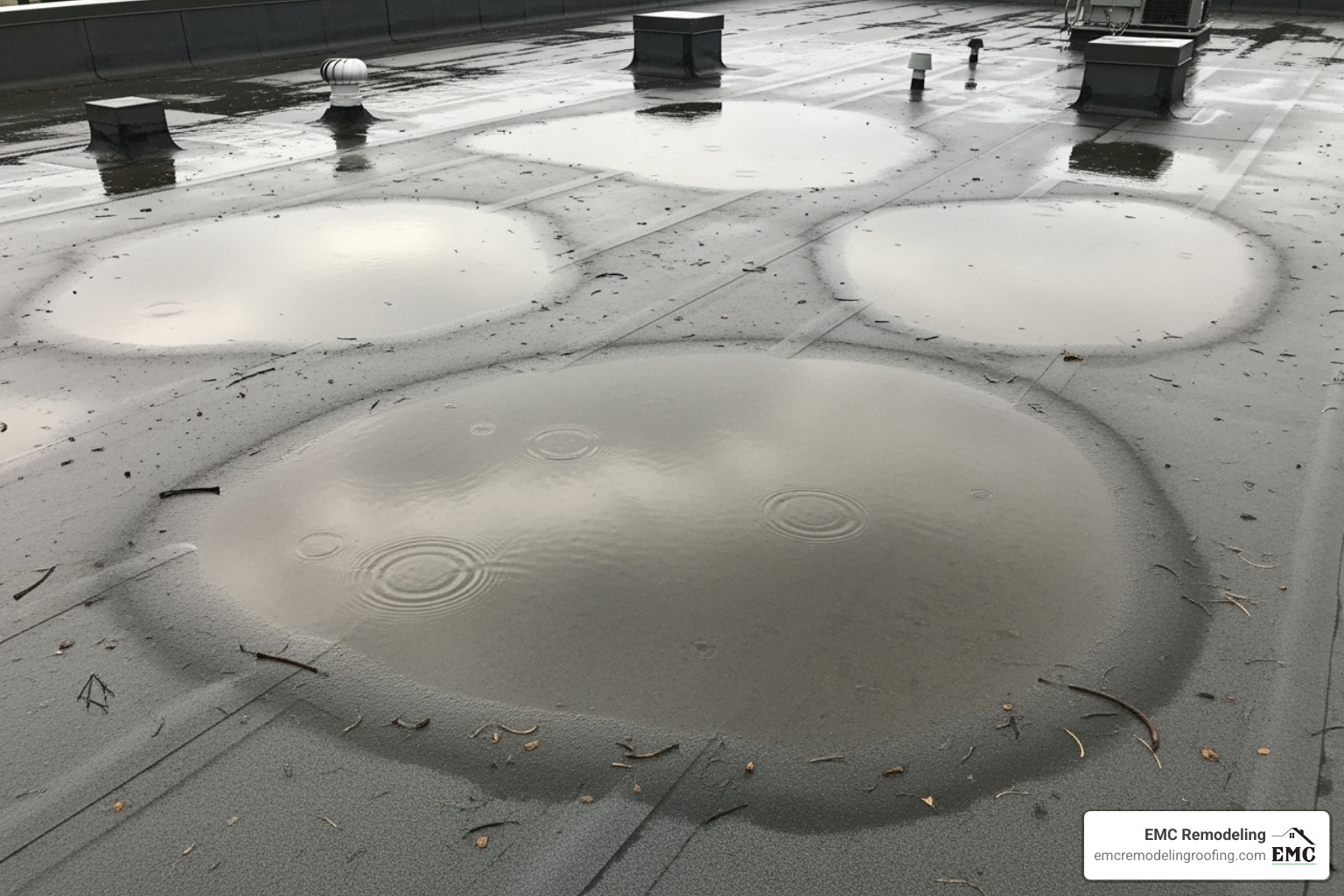
Think of your roof like your car – regular check-ups help you catch small issues before they become expensive emergencies. Here are the seven key warning signs that your flat roof repair needs attention:
Pooling Water and Leaks
Standing water is flat roofing’s biggest enemy. While the name suggests they’re completely flat, these roofs actually have a slight slope to help water drain. When that drainage system fails or gets blocked, water sits on your roof like a permanent puddle.
If water stays pooled for more than 48 hours after rainfall, you’ve got what we call “ponding.” This standing water acts like a magnifying glass under the Texas sun, accelerating membrane breakdown and creating weak spots that eventually become leaks.
Water stains on your ceiling are the most obvious indoor sign of trouble. These brown or yellowish marks often appear near roof edges or around vents and chimneys. Don’t ignore even small stains – they’re like the tip of an iceberg, with much bigger problems hiding above your ceiling.
A sagging roof deck is even more serious. If you notice any dipping or bowing in your roofline, that’s a sign that trapped water has compromised your roof’s structural integrity. This requires immediate professional attention to prevent potential collapse.
Membrane Damage: Cracks, Blisters, and Shrinkage
Central Texas weather puts your roof through a daily workout of heating up and cooling down. This constant expansion and contraction eventually takes its toll on roofing materials, creating several types of visible damage.
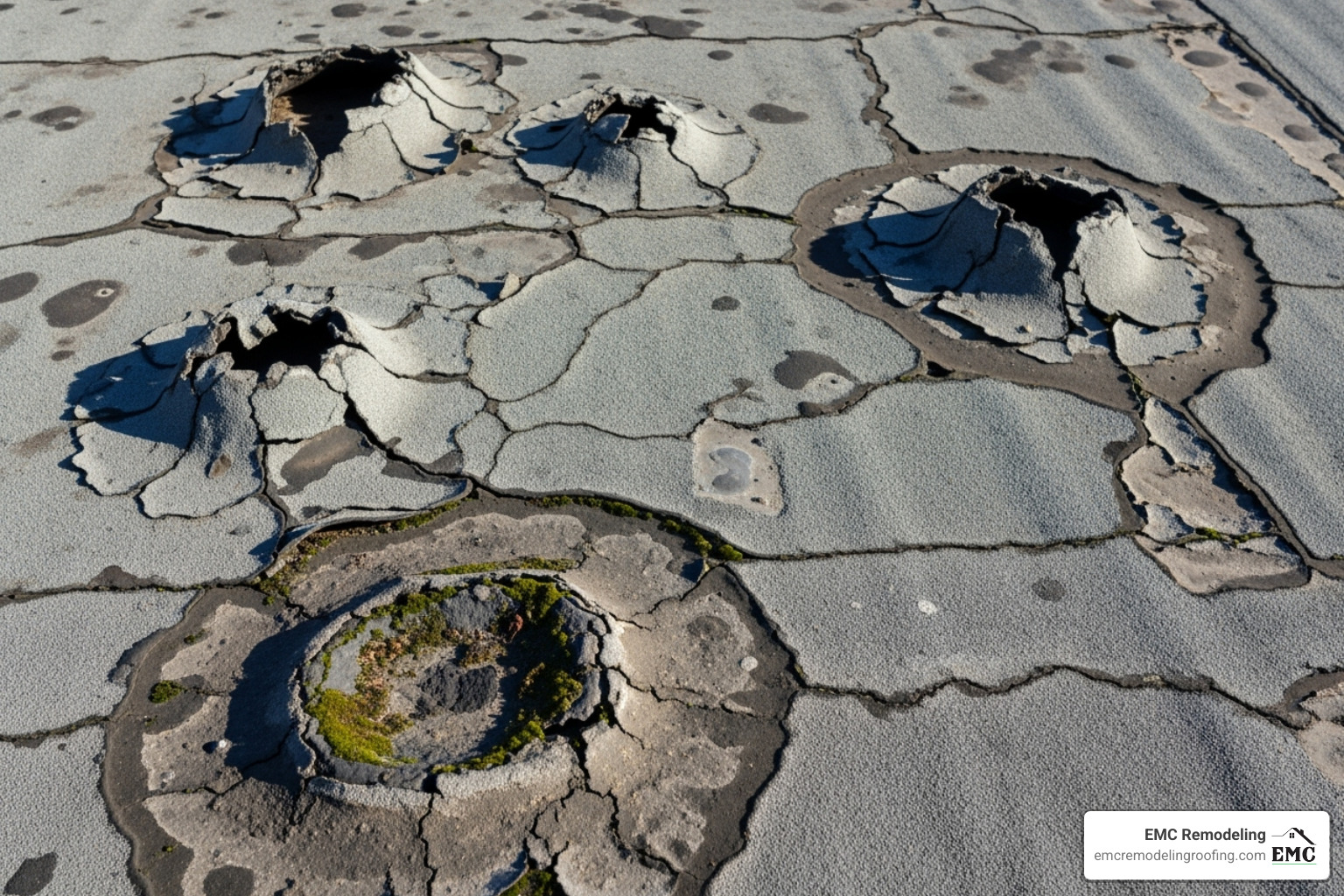
Blisters and bubbles in your roof membrane look exactly like what you’d expect – raised bumps that feel soft when you press on them. These form when moisture or air gets trapped under the membrane and expands in the heat. While small blisters might not leak immediately, they weaken the material and will eventually burst, creating direct pathways for water.
Cracks and tears develop as the membrane ages and loses flexibility. What starts as tiny hairline cracks can quickly grow into larger tears, especially during temperature swings. These openings let water seep through to the layers below.
Membrane shrinkage happens gradually over time, causing the roofing material to pull away from edges, flashing, and penetrations. This creates gaps where water can easily enter, often in areas that are hard to spot from ground level.
Damaged Flashing and High Energy Bills
Flashing problems are sneaky – they’re often the real culprit behind persistent leaks that seem impossible to locate. Flashing is the metal or rubber material that seals joints around chimneys, vents, skylights, and roof edges. When flashing fails, water finds its way into these vulnerable spots.
Look for loose, cracked, or missing flashing around any roof penetrations. Sometimes the flashing looks fine, but the sealant underneath has dried out and cracked, creating invisible leak pathways.
Here’s a warning sign many homeowners miss: unusually high energy bills. When your roof’s insulation gets compromised by leaks or membrane damage, your HVAC system works overtime trying to maintain comfortable temperatures. A sudden spike in your electricity bill, especially during extreme weather, might be your roof crying for help.
Your roof is a crucial part of your home’s thermal envelope. When it’s not doing its job properly, you’ll feel it in your wallet every month. Professional roof repair services can restore your roof’s energy efficiency and bring those bills back down to normal.
DIY vs. Pro Flat Roof Repair: A Safety and Process Breakdown
When it comes to flat roof repair, the difference between a quick fix and a lasting solution often comes down to understanding the process and respecting the safety requirements. As someone who’s been on countless roofs across Central Texas, I can tell you that while some homeowners are tempted to tackle repairs themselves, knowing when to DIY and when to call professionals can save you from both injury and costly mistakes.
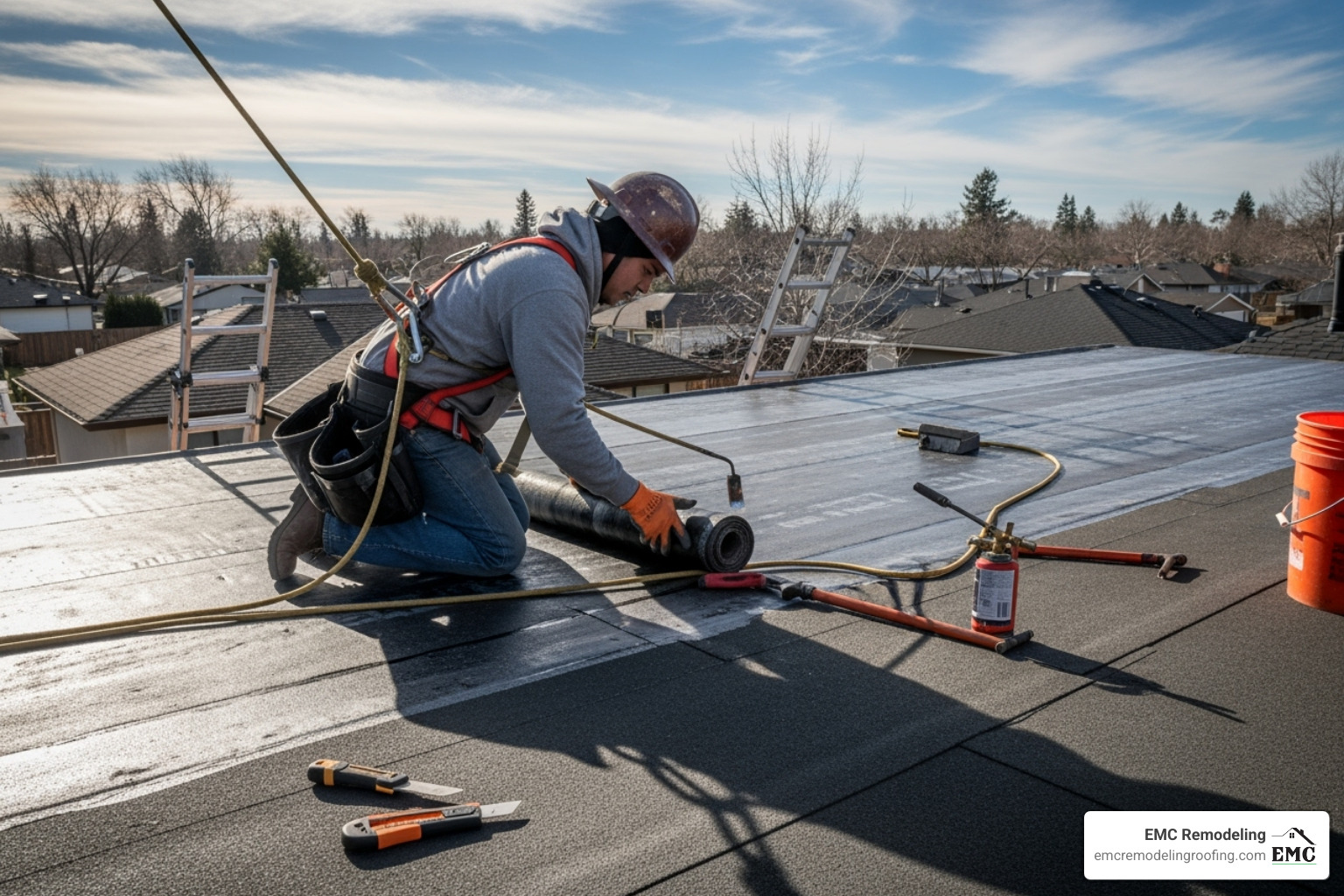
Your roof is literally your home’s first line of defense against Texas weather, and treating it with the respect it deserves means prioritizing safety above all else. Whether you’re considering a DIY approach or planning to hire professionals, understanding the repair process helps you make informed decisions about your home’s protection.
A Step-by-Step Guide to Minor Flat Roof Repair
For small, isolated problems like minor punctures or hairline cracks, a careful homeowner might handle the repair – but only under the right conditions. Safety first means working only on dry, sunny days when you can see clearly and the surface isn’t slippery. Never attempt roof work alone, and always use a fall prevention harness if you have one available.
The repair process itself is methodical and requires patience. Start by cleaning the area thoroughly, removing every bit of debris, dirt, or standing water. The surface must be bone dry – any moisture will prevent proper adhesion and doom your repair from the start.
Next, cut away damaged material using a sharp utility knife, removing any blistered, cracked, or loose membrane. Be conservative here – cut only what’s necessary, staying close to areas where the membrane is still well-adhered.
Apply roofing cement generously, spreading it about 1/8 inch thick and extending at least 6 inches beyond the damaged area. Think of this as creating a foundation for your patch. Then embed fiberglass mesh into the wet cement, smoothing out wrinkles and ensuring complete contact. This mesh provides the structural strength your repair needs.
Finally, seal the patch with another layer of roofing cement, completely covering the mesh. For extra protection against UV rays, you can sprinkle gravel onto the wet cement or apply a reflective coating once everything has cured.
When Professional Flat Roof Repair is Non-Negotiable
Some situations demand professional expertise, and trying to save money with DIY repairs can end up costing far more in the long run. Extensive damage like large tears, widespread blistering, or multiple leak points often indicates deeper problems that require comprehensive assessment and repair strategies.
Leaks you can’t locate are particularly tricky. Water has a sneaky way of traveling across a flat roof deck before finally dripping into your home, making the source incredibly difficult to pinpoint. Our team uses specialized leak detection techniques to find the actual problem, not just where the water eventually shows up.
Damage to structural components is absolutely a job for professionals. If you notice sagging areas or suspect the roof deck itself is compromised, this becomes a safety issue that goes far beyond simple membrane repair. TPO and PVC repairs also require specialized heat-welding equipment and specific training – attempting these without proper tools will likely void your warranty and create bigger problems.
Most importantly, if you have any safety concerns about working on your roof, please don’t risk it. Professional roofers have the experience, equipment, and insurance to handle these repairs safely. To ensure your investment is protected, it’s crucial to consult experts for a professional inspection. For more info about our roof repair services, our team at EMC Remodeling is here to help with comprehensive solutions.
The Critical Role of Flashing in Roof Integrity
Flashing might not be the most glamorous part of your roofing system, but it’s absolutely critical for water diversion and sealing joints where your roof meets other structures. Think chimneys, vents, skylights, and parapet walls – anywhere the continuous roof membrane gets interrupted.
These areas are common failure points because they’re inherently vulnerable. When flashing fails, water finds its way in quickly and can cause extensive damage before you even notice a problem. Proper installation is key – flashing that’s correctly installed and maintained can protect these vulnerable areas for decades without issue.
However, damaged flashing with visible cracks, rust, or loose sections needs immediate attention. For industry standards and best practices, the National Roofing Contractors Association (NRCA) provides comprehensive guidelines that ensure flashing installations meet the highest professional standards. When you work with experienced professionals, you’re getting repairs that follow these proven protocols for long-lasting protection.
Repair or Replace? A Cost-Benefit Analysis for Your Flat Roof
Making the right call between maintaining, repairing, or replacing your flat roof isn’t just about addressing today’s problem – it’s about making a smart investment that protects your home and your wallet for years to come. After helping countless Central Texas homeowners steer this decision, I’ve learned that the best choice depends on three key factors: your roof’s age, the extent of damage, and how often you’ve needed repairs lately.
Think of it like deciding whether to fix your car or buy a new one. Sometimes a simple tune-up keeps everything running smoothly, other times you need a major repair, and occasionally it’s time to start fresh. Your flat roof deserves the same thoughtful consideration.
Preventative Maintenance: Your First Line of Defense
Here’s the truth: preventative maintenance is hands-down the best investment you can make in your flat roof. It’s like taking vitamins – not exciting, but it keeps bigger problems away. Regular maintenance can extend your roof’s lifespan by years and save you thousands in emergency repairs.
I always tell homeowners that a well-maintained flat roof will consistently outlast a neglected one. Regular inspections are the foundation of good maintenance – we recommend annual check-ups at minimum, plus additional inspections after severe weather events. Central Texas storms can be brutal, and catching damage early makes all the difference.
Clearing debris might seem obvious, but you’d be surprised how many problems start with something as simple as clogged drains. Leaves, branches, and even tennis balls (yes, we’ve found those!) can block your drainage system, leading to that dreaded pooling water we discussed earlier.
Don’t forget to check your drains and scuppers regularly. These are your flat roof’s lifelines for water removal. When they’re working properly, water flows away from your roof efficiently. When they’re not, well, that’s when we get those panicked phone calls about ceiling leaks.
Warranty compliance is another crucial benefit of regular maintenance. Most roofing warranties require documented maintenance to remain valid. Skipping maintenance doesn’t just risk damage – it can void your warranty entirely. For a thorough check-up, consider a professional Roof Inspection.
Repair vs. Replacement: A Cost-Benefit Analysis
This is where the rubber meets the road – literally! The rule of thumb we use is simple: if repairs cost more than 50% of a new roof, replacement usually makes more financial sense. But the math isn’t everything.
Age matters tremendously in this decision. A 5-year-old roof with storm damage? Almost always worth repairing. A 20-year-old roof with multiple issues? Replacement often provides better long-term value. Frequency of repairs tells a story too – if you’re calling us every year for new problems, your roof might be trying to tell you something.
When repair makes sense, it’s usually because the damage is isolated and the rest of the roof is solid. Maybe a tree branch punctured your membrane, or a recent hailstorm caused some localized damage. These situations are perfect candidates for targeted repairs that can extend your roof’s life significantly.
Replacement becomes the smart choice when you’re dealing with widespread membrane deterioration, chronic leaking, or structural issues like sagging. Yes, it’s a bigger upfront investment, but a new roof comes with a new warranty – often 15-25 years of protection. Plus, modern materials offer improved energy efficiency that can significantly reduce your cooling costs during those scorching Texas summers.
The peace of mind factor shouldn’t be underestimated either. There’s something to be said for not worrying about your roof every time storm clouds roll in. Consider a full Roof Replacement when you’re ready for that level of security and performance.
Your Local Temple, TX Roofing Partner
For homeowners in Central Texas, having a reliable local expert is essential. Weather patterns, building codes, and material performance can vary significantly by region, and local expertise makes all the difference in getting the right solution for your specific situation.
At EMC Remodeling, we’re not just contractors – we’re your neighbors. As a family-operated business, we understand that your home is more than just a building; it’s where your family creates memories and finds comfort. That’s why we approach every project with the same care we’d want for our own homes.
Name: EMC Remodeling
Address: 5100 Midway Dr Suite 211, Temple, TX 76502
Phone: (254) 760-9268
Flat Roof FAQ: Your Top 3 Questions Answered by a Pro
After working with hundreds of Central Texas homeowners over the years, I’ve noticed the same questions come up time and again about flat roofs. Whether you’re considering a flat roof for your new home or dealing with issues on your current one, these are the answers that matter most.
How long does a typical flat roof last?
Here’s the honest truth: a well-maintained flat roof generally lasts 15-25 years, but that number can vary quite a bit. Think of it like asking how long a car will last – it depends on how you treat it! The longevity of your flat roof depends heavily on several key factors.
Material quality plays a huge role. Premium materials like high-grade TPO or PVC can push that lifespan toward the upper end of the range, while budget materials might fall short. Installation quality is equally important – even the best materials won’t perform if they’re not installed correctly by experienced professionals.
Our Texas climate is particularly demanding on roofing materials. The extreme temperature swings, intense UV exposure, and occasional severe weather can impact the actual lifespan. However, consistent preventative maintenance is your secret weapon. Homeowners who invest in regular inspections and minor repairs often see their roofs exceed the 25-year mark.
Are flat roofs more prone to leaking?
I get this question almost daily, and I understand why! Flat roofs used to have a reputation for being “leak magnets,” but modern flat roof repair techniques and materials have changed the game completely.
Yes, flat roofs face unique challenges because they don’t shed water as quickly as pitched roofs. When water sits on any surface longer, it has more opportunities to find weak spots. Issues like pooling water, damaged seams, and flashing failures can definitely lead to leaks if left unchecked.
But here’s the good news: today’s flat roofs, when properly installed and maintained, are incredibly reliable. The key factors are ensuring proper drainage with a slight slope, using quality materials, and staying on top of maintenance. We’ve installed flat roofs that have gone decades without a single leak issue.
The secret is being proactive rather than reactive. Regular inspections help us catch small problems before they become major headaches, and modern waterproof materials are far superior to what was available even 20 years ago.
What is the best flat roof material for the Texas heat?
Living in Central Texas, you know our summers don’t mess around! When it comes to beating the heat, light-colored, reflective materials like TPO and PVC are excellent choices for our climate.
These energy-efficient materials work like a giant white t-shirt for your roof – they reflect solar heat instead of absorbing it. This can significantly lower your cooling costs during those brutal July and August months. We’ve had customers report energy bill reductions of 10-15% after switching to reflective roofing materials.
TPO and PVC also handle thermal stress better than darker materials. When your roof expands and contracts less dramatically due to temperature changes, the material lasts longer and requires fewer repairs over time.
While other materials like EPDM and Modified Bitumen can work in Texas, their heat absorption properties might require additional reflective coatings to maximize energy efficiency. The upfront investment in reflective materials typically pays for itself through energy savings within just a few years.
Your Flat Roof’s Future: Partner with a Central Texas Expert

Your flat roof isn’t just another part of your home – it’s your family’s shield against Central Texas weather, from blazing summer heat to unexpected hailstorms. After walking through everything from material choices to repair techniques, one thing becomes crystal clear: taking care of your flat roof isn’t just maintenance, it’s peace of mind.
Think about it this way: proactive maintenance today saves you from emergency calls tomorrow. Those small cracks you ignore in March could become major leaks by July. Timely flat roof repair isn’t an expense – it’s an investment that keeps your energy bills reasonable and your home comfortable year-round.
The beauty of understanding your flat roof system is that you’re no longer flying blind. You know what pooling water means, you can spot membrane damage before it becomes a crisis, and you understand when to tackle a small repair yourself versus when to call in the experts. This knowledge transforms you from a reactive homeowner into a proactive protector of your investment.
Here in Central Texas, we face unique challenges that many roofing companies simply don’t understand. Our temperature swings, intense UV exposure, and sudden weather changes require local expertise. That’s where having a trusted partner makes all the difference.
As a family-operated business serving Temple and surrounding communities, EMC Remodeling brings something special to every project: we treat your home like it’s our own. When you’re dealing with a roof emergency at 2 AM or planning a major replacement, you want someone who understands both the technical aspects and the stress you’re feeling.
Don’t wait until water stains appear on your ceiling or your energy bills skyrocket. Your roof is working hard to protect everything you value most. Contact the top-rated roofer in Temple, TX today for a comprehensive inspection that gives you the full picture of your roof’s health and your peace of mind.
